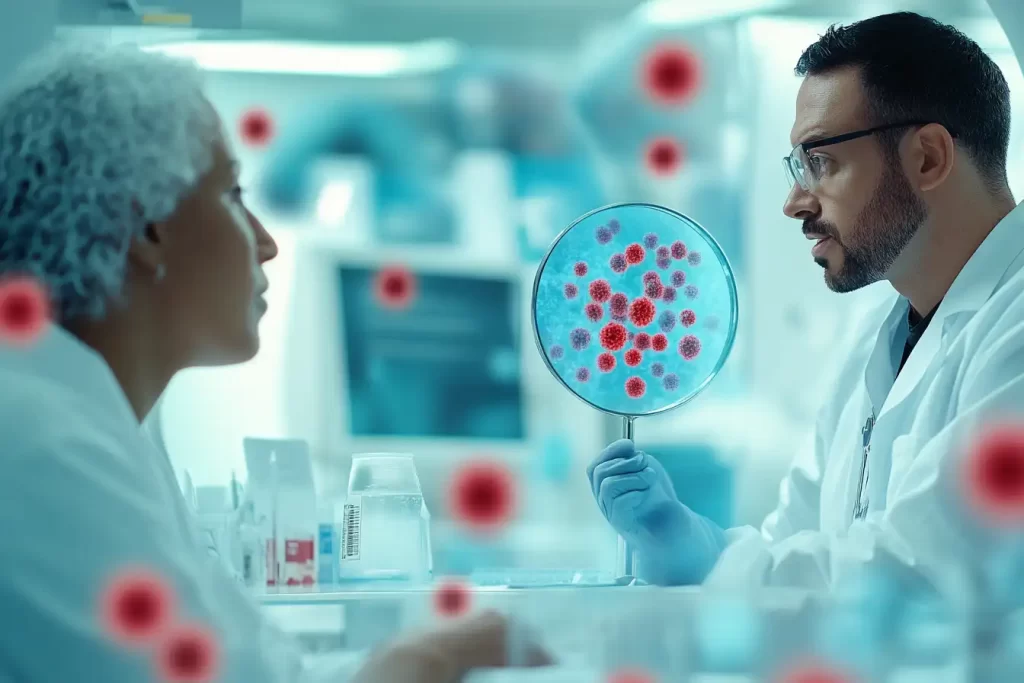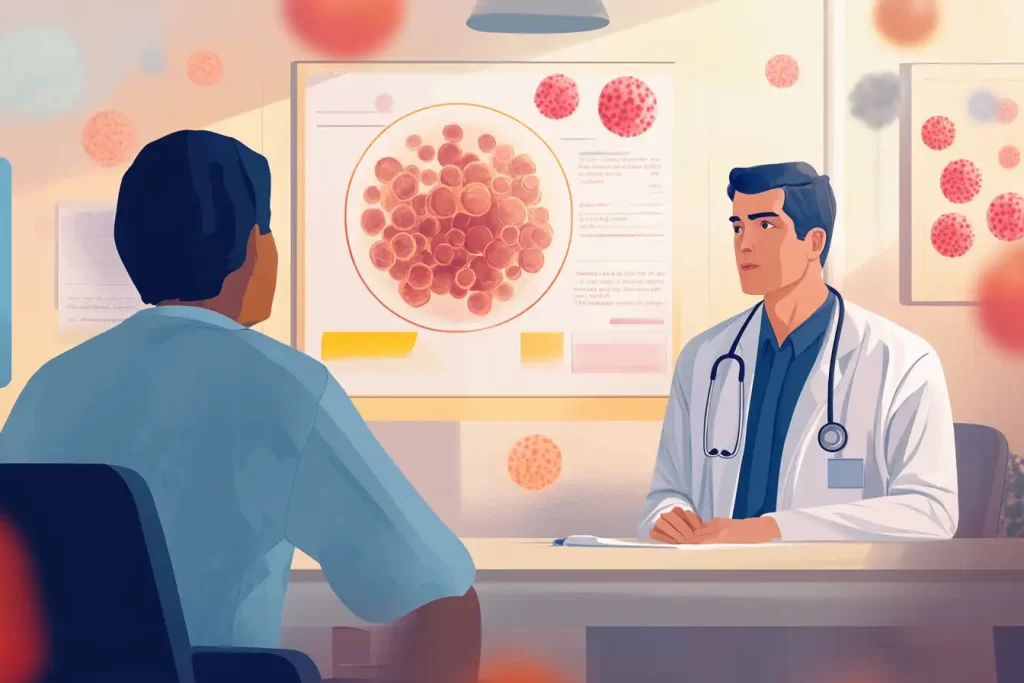Blood Cancer Symptoms: How to Spot the Early Warning Signs and identifying the Early Signs and Symptoms of Blood Cancer are critical for early intervention. Blood cancer occurs when abnormal blood cells grow uncontrollably, interfering with the normal functions of healthy blood cells. These cancers typically begin in the bone marrow where blood is produced. There are three primary types of blood cancer:
- Leukemia: Affects the blood and bone marrow.
- Lymphoma: Targets the lymphatic system.
- Myeloma: Develops in plasma cells within the bone marrow.
Each type of blood cancer has unique characteristics, but many early symptoms overlap. Let’s delve into the early signs that may indicate blood cancer.

What is Blood Cancer?
BBlood Cancer Symptoms: How to Spot the Early Warning Signs and identifying the Early Signs and Symptoms of Blood Cancer are critical for early intervention. Blood cancer refers to a group of malignancies that affect the production and function of blood cells. It occurs when abnormal blood cells grow uncontrollably, interfering with the normal functions of healthy blood cells. These healthy cells are responsible for carrying oxygen, fighting infections, and clotting the blood. When abnormal cells take over, they impair these critical functions, leading to serious health complications.
Blood cancer typically originates in the bone marrow, the soft, spongy tissue inside bones where blood cells are produced. In normal conditions, the bone marrow produces three main types of blood cells:
- Red Blood Cells (RBCs): Carry oxygen throughout the body.
- White Blood Cells (WBCs): Fight infections and support the immune system.
- Platelets: Help with blood clotting to stop bleeding.
When blood cancer develops, it disrupts the normal production of these cells. This disruption can lead to anemia (low RBC count), increased susceptibility to infections (low WBC count), and excessive bleeding or bruising (low platelet count).
There are three primary types of blood cancer:
- Leukemia: This type of blood cancer originates in the bone marrow and affects the blood. It leads to the overproduction of abnormal white blood cells, which crowd out healthy cells. Leukemia can be acute (fast-growing) or chronic (slow-growing), and it impacts the body’s ability to fight infections and produce healthy blood cells.
- Lymphoma: Lymphoma targets the lymphatic system, which is a crucial part of the immune system. The lymphatic system includes lymph nodes, the spleen, and lymphatic vessels. Abnormal lymphocytes (a type of white blood cell) accumulate in these areas, forming tumors and impairing the body’s ability to fight infections. The two main types of lymphoma are Hodgkin’s lymphoma and non-Hodgkin’s lymphoma.
- Myeloma: Myeloma affects plasma cells, a type of white blood cell found in the bone marrow. Plasma cells are responsible for producing antibodies to fight infections. In myeloma, abnormal plasma cells multiply uncontrollably, producing ineffective antibodies and weakening the immune system. This condition can lead to bone damage, kidney issues, and anemia.
Each type of blood cancer has unique characteristics, progression rates, and treatment options. However, the early signs and symptoms of blood cancer often overlap, making it essential to pay attention to any unusual health changes.
- Leukemia: Symptoms include frequent infections, fatigue, easy bruising or bleeding, and bone pain.
- Lymphoma: Symptoms may involve swollen lymph nodes, night sweats, fever, and unexplained weight loss.
- Myeloma: Symptoms can include bone pain, frequent fractures, high calcium levels, kidney problems, and fatigue.
Understanding the type of blood cancer and how it affects the body is crucial for early detection and effective treatment. Recognizing blood cancer symptoms and the early signs and symptoms of blood cancer can help ensure timely medical intervention and better health outcomes.
Early Signs and Symptoms of Blood Cancer
1. Unexplained Fatigue
One of the most common early symptoms of blood cancer is persistent, unexplained fatigue. This isn’t the typical tiredness you feel after a long day. Instead, it’s a deep exhaustion that doesn’t improve with rest. This type of fatigue can be due to the cancer cells crowding out healthy blood cells, leading to anemia.
- Key takeaway: If you experience extreme tiredness that doesn’t seem to have a cause, consult a healthcare provider.
2. Frequent Infections
Blood cancers, especially leukemia, can weaken your immune system by reducing the number of healthy white blood cells. As a result, you may experience frequent infections, such as colds, sinus infections, or respiratory infections.
- Key takeaway: If you’re getting sick more often than usual, or if infections linger longer, it’s worth getting checked out.
3. Swollen Lymph Nodes
Lymph nodes play a key role in filtering harmful substances from the body. In lymphoma, cancer cells may cause lymph nodes to swell, particularly in the neck, armpits, or groin. These lumps are usually painless but can become tender if they enlarge significantly.
- Key takeaway: Swollen lymph nodes that don’t go away within a few weeks should be examined by a healthcare professional.
4. Unexplained Weight Loss
Sudden and unexplained weight loss is another red flag. If you lose more than 10% of your body weight over six months without changes to your diet or exercise routine, it may be an early sign of blood cancer.
- Key takeaway: Significant weight loss without trying could indicate a serious health issue, including blood cancer.
5. Night Sweats
Excessive night sweating, especially when severe enough to soak your clothes and bedding, can be an early symptom of blood cancer, particularly lymphoma.
- Key takeaway: If night sweats persist and are accompanied by other symptoms like fatigue or weight loss, seek medical advice.
6. Bruising and Bleeding Easily
Blood cancers can affect platelet production, leading to easy bruising and excessive bleeding. You may notice frequent nosebleeds, bleeding gums, or small red spots on the skin (petechiae).
- Key takeaway: If you bruise or bleed more easily than usual, this could indicate a problem with your blood cells.
7. Bone Pain or Joint Pain
In leukemia and myeloma, cancer cells can accumulate in the bone marrow, causing pain in the bones or joints. The pain is often persistent and may worsen at night.
- Key takeaway: Unexplained bone or joint pain that doesn’t go away should be evaluated.
8. Shortness of Breath
Anemia caused by blood cancer can result in shortness of breath, even during minimal physical activity. Reduced red blood cell production means less oxygen is delivered to your organs.
- Key takeaway: If you feel breathless without a clear reason, consider getting a blood test.
9. Persistent Fever
A persistent or recurrent fever without an obvious cause may be a sign of blood cancer. The fever is often low-grade and accompanied by other symptoms like night sweats or fatigue.
- Key takeaway: Persistent fevers should not be ignored, especially if other symptoms are present.
10. Abdominal Pain or Swelling
Enlargement of the liver or spleen (hepatosplenomegaly) can cause discomfort or swelling in the abdomen. This is more common in leukemia and lymphoma.
- Key takeaway: Persistent abdominal pain or a feeling of fullness should prompt a medical evaluation.
Specific Symptoms for Different Types of Blood Cancer
Understanding the specific symptoms for different types of blood cancer can help with early detection and appropriate treatment. Each type of blood cancer presents with unique warning signs that may overlap but have distinct differences.
Leukemia Symptoms
Leukemia affects the blood and bone marrow, leading to a range of symptoms caused by the overproduction of abnormal white blood cells. The early signs of leukemia include:
- Pale Skin: Due to anemia caused by low red blood cell count.
- Nosebleeds and Gum Bleeding: Caused by low platelet levels.
- Recurrent Infections: Resulting from a weakened immune system.
- Bone Pain: Pain and tenderness in the bones, particularly in the long bones of the legs and arms.
- Fatigue: Persistent tiredness not relieved by rest.
Lymphoma Symptoms
Lymphoma targets the lymphatic system, which includes lymph nodes, spleen, and other organs. Early signs of lymphoma include:
- Swollen Lymph Nodes: Painless swelling in the neck, armpits, or groin.
- Persistent Itching: Unexplained and persistent itching, especially on the legs and arms.
- Night Sweats: Severe sweating at night, often soaking clothes and bedding.
- Chest Pain or Breathing Issues: In cases where lymphoma affects lymph nodes in the chest.
- Unexplained Weight Loss: Losing weight rapidly without a clear reason.
Myeloma Symptoms
Myeloma develops in plasma cells within the bone marrow and can cause significant damage to bones and the immune system. Early symptoms of myeloma include:
- Bone Pain: Persistent pain in the back, ribs, or hips.
- Frequent Fractures: Bones become fragile and break easily.
- High Calcium Levels: Leading to symptoms like nausea, confusion, and excessive thirst.
- Kidney Problems: Reduced kidney function or kidney failure.
- Fatigue and Weakness: Resulting from anemia.

When to See a Doctor
If you experience any of the above symptoms persistently, it’s essential to seek medical advice. Early diagnosis of blood cancer can significantly improve treatment outcomes. Your doctor may order blood tests, imaging scans, or biopsies to determine the cause of your symptoms.
It is important not to dismiss symptoms like persistent fatigue, unexplained weight loss, swollen lymph nodes, or frequent infections. These can sometimes be mistakenly attributed to stress, lifestyle, or minor illnesses. However, if these symptoms persist for more than two weeks or worsen over time, a thorough medical evaluation is warranted.
In particular, if you have multiple symptoms simultaneously, such as night sweats, bone pain, and persistent fever, you should prioritize scheduling a consultation with a healthcare professional. A prompt diagnosis can lead to early intervention, which may greatly improve your prognosis and increase the effectiveness of treatment options.
Regular health check-ups and screenings are also important, especially if you have risk factors such as a family history of blood cancer, exposure to harmful chemicals, or a weakened immune system. Don’t hesitate to advocate for your health and ask your doctor for specific tests if you suspect something is wrong.

Risk Factors for Blood Cancer
1. Genetic Predisposition
A family history of blood cancer or inherited genetic disorders, such as Down syndrome, can increase your risk. Mutations in specific genes may also predispose individuals to blood cancers like leukemia, lymphoma, or myeloma.
2. Exposure to Chemicals or Radiation
Long-term exposure to certain chemicals, such as benzene (commonly found in industrial settings), can elevate your risk of developing blood cancer. Previous radiation therapy or exposure to high levels of radiation also increases the likelihood.
3. Age and Gender
Blood cancers are more common in older adults. For example, leukemia is more frequently diagnosed in people over the age of 55. Certain types of blood cancer, such as lymphoma, are more prevalent in men than in women.
4. Weakened Immune System
Conditions that compromise the immune system, such as HIV/AIDS or autoimmune diseases, can increase the risk of blood cancer. Organ transplant recipients who take immunosuppressive drugs are also at higher risk.
5. Viral Infections
Diagnosis and Screening
1. Blood Tests
Blood tests are the first step in diagnosing blood cancer. A Complete Blood Count (CBC) measures the levels of red blood cells, white blood cells, and platelets. Abnormalities in these counts can indicate the presence of blood cancer. Additional blood tests, such as a Peripheral Blood Smear or Flow Cytometry, help identify the type and characteristics of abnormal cells.
2. Bone Marrow Biopsy
A bone marrow biopsy involves extracting a small sample of bone marrow, usually from the hip bone, using a needle. This procedure allows doctors to examine the marrow for abnormal cells under a microscope. It provides definitive information about the type and progression of blood cancer and helps determine the best treatment plan.
3. Imaging Scans
Imaging tests, such as CT Scans (Computed Tomography), MRI (Magnetic Resonance Imaging), and PET Scans (Positron Emission Tomography), are used to detect swollen lymph nodes, organ enlargement, or bone abnormalities. These scans help determine the extent of the disease and whether it has spread to other parts of the body.
4. Lymph Node Biopsy
In cases of suspected lymphoma, a lymph node biopsy may be performed. A small piece of lymph node tissue is removed and examined for cancerous cells. This helps confirm a lymphoma diagnosis and identify its specific type.
5. Cytogenetic Analysis
Cytogenetic analysis involves examining the chromosomes of cells from the blood, bone marrow, or lymph nodes. This test can detect genetic abnormalities that are associated with different types of blood cancer. Identifying these abnormalities can help doctors determine the specific subtype of cancer and guide treatment decisions.
Conclusion
Recognizing Blood Cancer Symptoms: How to Spot the Early Warning Signs and understanding the Early Signs and Symptoms of Blood Cancer can make a significant difference in diagnosis and treatment outcomes. Symptoms such as persistent fatigue, swollen lymph nodes, unexplained weight loss, and frequent infections should not be ignored. If these symptoms persist, seeking medical attention promptly is essential.
Early diagnosis of blood cancer can lead to more effective treatment options and better survival rates. Regular health check-ups, especially if you have known risk factors like a family history of blood cancer or exposure to harmful chemicals, can help detect potential issues early. Remember, being proactive and informed about the early signs and symptoms of blood cancer can empower you to take control of your health and improve your chances of successful treatment.
Stay vigilant, listen to your body, and consult a healthcare professional if something feels wrong. Early detection can save lives, and understanding the blood cancer symptoms ensures you or your loved ones receive timely care.
FAQs
1. What are the most common early symptoms of blood cancer?
Persistent fatigue, swollen lymph nodes, unexplained weight loss, and frequent infections are among the most common early symptoms.
2. Can blood cancer be detected through a routine blood test?
Yes, routine blood tests can sometimes detect abnormalities that indicate blood cancer, but further tests are needed for confirmation.
3. How do swollen lymph nodes feel if it’s blood cancer?
They usually feel firm, painless, and may appear in the neck, armpits, or groin.
4. Is frequent bruising always a sign of blood cancer?
Not always, but if bruising is accompanied by other symptoms like fatigue or bleeding, it’s best to consult a doctor.
5. Can blood cancer be cured if detected early?
Early detection improves the chances of successful treatment, though outcomes depend on the type and stage of the cancer.


0 thoughts on “Blood Cancer Symptoms: How to Spot the Early Warning Signs”